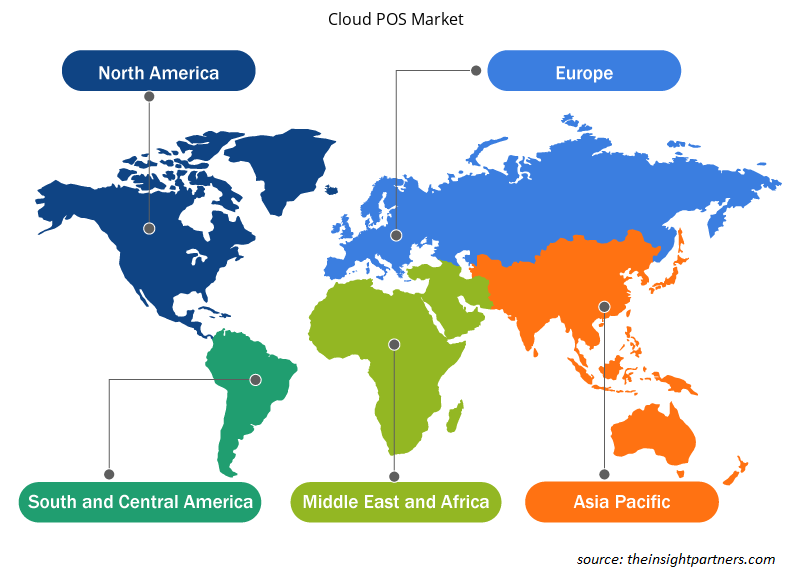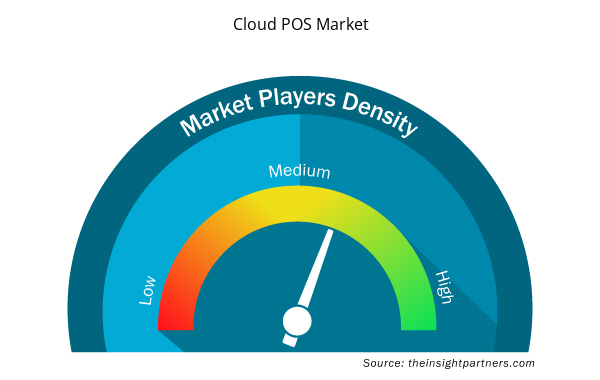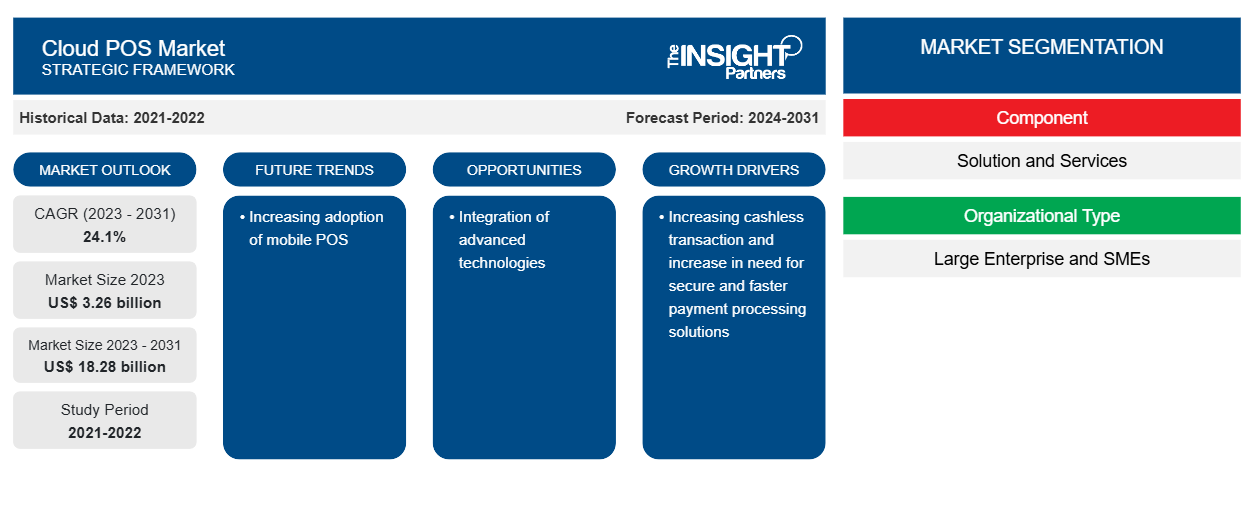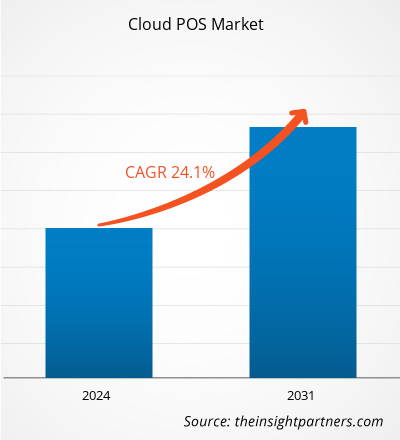Se espera que el tamaño del mercado de POS en la nube crezca de US$ 3.26 mil millones en 2023 a US$ 18.28 mil millones en 2031; se estima que crecerá a una CAGR del 24,1% entre 2023 y 2031. Es probable que la creciente adopción de POS móviles siga siendo una tendencia clave del mercado de POS en la nube.
Análisis del mercado de POS en la nube
El mercado de los puntos de venta (POS) en la nube ha experimentado un crecimiento y una transformación significativos en los últimos años. Los sistemas POS basados en la nube han surgido como una alternativa popular a las soluciones locales tradicionales, ofreciendo a las empresas una mayor flexibilidad, escalabilidad y accesibilidad. Estos sistemas utilizan tecnología de computación en la nube para almacenar y procesar datos transaccionales, eliminando la necesidad de hardware físico y proporcionando conectividad en tiempo real. Una de las principales ventajas de los sistemas POS basados en la nube es su capacidad para agilizar las operaciones y mejorar la eficiencia para empresas de todos los tamaños. Ofrecen funciones como gestión de inventario, informes de ventas y análisis, gestión de relaciones con los clientes e integración con otras aplicaciones comerciales. Con un POS en la nube, las empresas pueden realizar un seguimiento de las ventas fácilmente, supervisar los niveles de inventario y obtener información valiosa sobre sus operaciones, lo que conduce a una mejor toma de decisiones y una mejor experiencia del cliente. El POS en la nube ha sido objeto de una adopción generalizada en varias industrias, incluidas la venta minorista, la hostelería, los restaurantes y el comercio electrónico. Las pequeñas y medianas empresas, en particular, han adoptado soluciones POS en la nube debido a su asequibilidad y facilidad de implementación. Además, la escalabilidad de los sistemas de punto de venta basados en la nube permite a las empresas ampliar sus operaciones y agregar funcionalidades adicionales según sea necesario con facilidad. La seguridad ha sido un tema crítico para los proveedores de puntos de venta en la nube.
Descripción general del mercado de POS en la nube
La base de las soluciones de punto de venta basadas en la nube es el concepto de fácil instalación y desinstalación; la empresa puede añadir o quitar servicios en cualquier momento, según sus necesidades y las de sus clientes. Las empresas pueden ahorrar dinero pagando por los servicios que utilizan en lugar de los mecanismos a prueba de fallos y los requisitos de preparación para el futuro de los puntos de venta tradicionales en las instalaciones. El proveedor de soluciones también se encargará del mantenimiento y la conservación de las soluciones de punto de venta basadas en la nube, por lo que los propietarios de empresas no tendrán que preocuparse de que estos sistemas de punto de venta funcionen de forma continua.
Personalice este informe según sus necesidades
Obtendrá personalización en cualquier informe, sin cargo, incluidas partes de este informe o análisis a nivel de país, paquete de datos de Excel, así como también grandes ofertas y descuentos para empresas emergentes y universidades.
- Obtenga las principales tendencias clave del mercado de este informe.Esta muestra GRATUITA incluirá análisis de datos, desde tendencias del mercado hasta estimaciones y pronósticos.
Factores impulsores y oportunidades del mercado de POS en la nube POS Market Drivers and Opportunities
Aumenta la necesidad de soluciones de procesamiento de pagos seguras y más rápidas para favorecer el crecimiento del mercado
El aumento de la necesidad de soluciones de procesamiento de pagos seguras y más rápidas ha sido un factor importante en el crecimiento del mercado de POS en la nube. A medida que las empresas se esfuerzan por proporcionar experiencias de pago eficientes y sin inconvenientes a sus clientes, los sistemas POS basados en la nube han surgido como una opción preferida. En primer lugar, las soluciones POS en la nube ofrecen medidas de seguridad mejoradas para proteger los datos de pago confidenciales. Con un cifrado sólido, tokenización y cumplimiento de las normas de la industria, como el Estándar de seguridad de datos de la industria de tarjetas de pago (PCI DSS), estos sistemas brindan un entorno seguro para procesar transacciones. Al trasladar la responsabilidad de la seguridad de los datos a proveedores de servicios en la nube confiables, las empresas pueden mitigar los riesgos asociados con las violaciones de datos y el acceso no autorizado. Además, los sistemas POS en la nube permiten un procesamiento de pagos más rápido, lo que beneficia a las empresas y los clientes. Los sistemas POS locales tradicionales a menudo requieren actualizaciones y mantenimiento manuales, lo que resulta en posibles demoras e ineficiencias.POS market. As businesses strive to provide seamless and efficient payment experiences to their customers, cloud-based POS systems have emerged as a preferred choice. First and foremost, cloud POS solutions offer enhanced security measures to protect sensitive payment data. With robust encryption, tokenization, and compliance with industry norms such as the Payment Card Industry Data Security Standard (PCI DSS), these systems provide a secure environment for processing transactions. By shifting the responsibility of data security to trusted cloud service providers, businesses can mitigate the risks associated with data breaches and unauthorized access. Moreover, cloud POS systems enable faster payment processing, benefiting businesses and customers. Traditional on-premises POS systems often require manual updates and maintenance, resulting in potential delays and inefficiencies.
Capacidad para gestionar grandes volúmenes de transacciones: una oportunidad en el mercado de POS en la nube
Los sistemas POS basados en la nube pueden gestionar grandes volúmenes de transacciones. Durante los períodos pico, como las vacaciones o los eventos promocionales, las empresas experimentan un aumento en el tráfico de clientes y las transacciones de pago. Los sistemas POS en la nube pueden escalar fácilmente sus recursos para adaptarse al aumento de la demanda, lo que garantiza un procesamiento de pagos ininterrumpido y evita cuellos de botella que pueden provocar la frustración de los clientes o la pérdida de oportunidades de venta. Además, las soluciones POS en la nube ofrecen capacidades de integración con varios métodos y canales de pago. Pueden conectarse sin problemas con billeteras móviles, opciones de pago sin contacto y pasarelas de pago en línea, lo que brinda a los clientes una amplia gama de opciones y mejora la comodidad. Esta flexibilidad en la aceptación de pagos ayuda a las empresas a atender las preferencias cambiantes de los clientes y adaptarse a las tendencias cambiantes de la industria.
Informe de segmentación del mercado de POS en la nube
Los segmentos clave que contribuyeron a la derivación del análisis del mercado de POS en la nube son el componente, el tipo de organización y los usuarios finales.
- Según el componente, el mercado de POS en la nube se segmenta en soluciones y servicios.
- Según el tipo de organización, el mercado de POS en la nube se segmenta en grandes empresas y pymes.
- Según los usuarios finales, el mercado de POS en la nube está segmentado en venta minorista y bienes de consumo, viajes y hotelería, medios y entretenimiento, transporte y logística, atención médica y otros.
Análisis de la cuota de mercado de los puntos de venta en la nube por geografía
- El mercado de POS en la nube está segmentado en cinco regiones principales: América del Norte, Europa, Asia Pacífico (APAC), Oriente Medio y África (MEA) y América del Sur y Central. Asia Pacífico dominó el mercado en 2023, con su creciente adopción y creciente demanda de soluciones tecnológicas avanzadas en los sectores minorista y hotelero. El fuerte crecimiento económico de la región, la expansión de la industria del comercio electrónico y las crecientes expectativas de los clientes han contribuido a su importante participación de mercado en el segmento de POS en la nube. Las soluciones de POS basadas en la nube han ganado terreno en la región de Asia Pacífico debido a su capacidad para brindar opciones rentables y escalables para empresas de todos los tamaños.
Perspectivas regionales del mercado de POS en la nube
Los analistas de Insight Partners explicaron en detalle las tendencias y los factores regionales que influyen en el mercado de POS en la nube durante el período de pronóstico. Esta sección también analiza los segmentos y la geografía del mercado de POS en la nube en América del Norte, Europa, Asia Pacífico, Medio Oriente y África, y América del Sur y Central.

- Obtenga datos regionales específicos para el mercado de POS en la nube
Alcance del informe de mercado de POS en la nube
| Atributo del informe | Detalles |
|---|---|
| Tamaño del mercado en 2023 | 3.260 millones de dólares estadounidenses |
| Tamaño del mercado en 2031 | US$ 18.280 millones |
| CAGR global (2023 - 2031) | 24,1% |
| Datos históricos | 2021-2022 |
| Período de pronóstico | 2024-2031 |
| Segmentos cubiertos | Por componente
|
| Regiones y países cubiertos | América del norte
|
| Líderes del mercado y perfiles de empresas clave |
|
Densidad de actores del mercado de POS en la nube: comprensión de su impacto en la dinámica empresarial
El mercado de POS en la nube está creciendo rápidamente, impulsado por la creciente demanda de los usuarios finales debido a factores como la evolución de las preferencias de los consumidores, los avances tecnológicos y una mayor conciencia de los beneficios del producto. A medida que aumenta la demanda, las empresas amplían sus ofertas, innovan para satisfacer las necesidades de los consumidores y aprovechan las tendencias emergentes, lo que impulsa aún más el crecimiento del mercado.
La densidad de actores del mercado se refiere a la distribución de las empresas o firmas que operan dentro de un mercado o industria en particular. Indica cuántos competidores (actores del mercado) están presentes en un espacio de mercado determinado en relación con su tamaño o valor total de mercado.
Las principales empresas que operan en el mercado de POS en la nube son:
- Cuadrado, Inc.
- Intuit, Inc.
- Corporación Oracle
- Tienda de aplicaciones de Shopify, Inc.
- Tostada, Inc.
- Vend limitada
Descargo de responsabilidad : Las empresas enumeradas anteriormente no están clasificadas en ningún orden particular.

- Obtenga una descripción general de los principales actores clave del mercado de Cloud POS
Noticias y desarrollos recientes del mercado de POS en la nube
El mercado de POS en la nube se evalúa mediante la recopilación de datos cualitativos y cuantitativos a partir de una investigación primaria y secundaria, que incluye publicaciones corporativas importantes, datos de asociaciones y bases de datos. A continuación, se incluye una lista de los avances en el mercado de POS en la nube:
- En septiembre de 2022, Square, Inc. (ahora conocida como Block, Inc.) presentó a millones de vendedores en todo Estados Unidos su función Tap to Pay en iPhone. La función, disponible dentro de la aplicación Square Point of Sale para iOS, permitió a los comerciantes de todos los tamaños aceptar pagos sin contacto directamente desde sus iPhones, sin requisitos de hardware adicionales y sin costos adicionales para el vendedor.
(Fuente: Square, Inc., comunicado de prensa)
- En junio de 2022, Openbravo anunció el lanzamiento de su nuevo sistema de punto de venta (POS) para restaurantes de comida rápida (QSR) y restaurantes informales de comida rápida. Las características clave de la solución incluyen la creación rápida y flexible de menús y un potente motor de precios con opciones como la definición de precios específicos en función de las zonas del restaurante y los modos de entrega.
(Fuente: Openbravo, Nota de Prensa)
Informe de mercado de Cloud POS: cobertura y resultados
El informe "Tamaño y pronóstico del mercado de POS en la nube (2021-2031)" proporciona un análisis detallado del mercado que cubre las áreas mencionadas a continuación:
- Tamaño y pronóstico del mercado de POS en la nube a nivel global, regional y nacional para todos los segmentos clave del mercado cubiertos bajo el alcance
- Dinámica del mercado de POS en la nube, como impulsores, restricciones y oportunidades clave
- Tendencias del mercado de POS en la nube
- Análisis detallado de las cinco fuerzas de Porter y PEST y FODA
- Análisis del mercado global y regional que cubre las tendencias clave del mercado, los principales actores, las regulaciones y los desarrollos recientes del mercado.
- Panorama de la industria del mercado de POS en la nube y análisis de la competencia que abarca la concentración del mercado, el análisis de mapas de calor, los actores destacados y los desarrollos recientes
- Perfiles detallados de empresas
- Análisis histórico (2 años), año base, pronóstico (7 años) con CAGR
- Análisis PEST y FODA
- Tamaño del mercado Valor/volumen: global, regional, nacional
- Industria y panorama competitivo
- Conjunto de datos de Excel



Report Coverage
Revenue forecast, Company Analysis, Industry landscape, Growth factors, and Trends

Segment Covered
This text is related
to segments covered.

Regional Scope
North America, Europe, Asia Pacific, Middle East & Africa, South & Central America

Country Scope
This text is related
to country scope.
Preguntas frecuentes
The global cloud POS market was estimated to be US$ 3.26 billion in 2023 and is expected to grow at a CAGR of 24.1% during the forecast period 2024 - 2031.
The major factors driving the cloud POS market are increasing cashless transactions and the increased need for secure and faster payment processing solutions
The increasing adoption of mobile POS is anticipated to play a significant role in the global cloud POS market in the coming years.
The key players holding majority shares in the global cloud POS market are Square, Inc., Intuit, Inc., Oracle Corporation, Shopify, Inc., Toast, Inc., and Shopify, Inc.
Asia Pacific is expected to hold the highest market share in the cloud POS market.
Trends and growth analysis reports related to Technology, Media and Telecommunications : READ MORE..
The Insight Partners performs research in 4 major stages: Data Collection & Secondary Research, Primary Research, Data Analysis and Data Triangulation & Final Review.
- Data Collection and Secondary Research:
As a market research and consulting firm operating from a decade, we have published and advised several client across the globe. First step for any study will start with an assessment of currently available data and insights from existing reports. Further, historical and current market information is collected from Investor Presentations, Annual Reports, SEC Filings, etc., and other information related to company’s performance and market positioning are gathered from Paid Databases (Factiva, Hoovers, and Reuters) and various other publications available in public domain.
Several associations trade associates, technical forums, institutes, societies and organization are accessed to gain technical as well as market related insights through their publications such as research papers, blogs and press releases related to the studies are referred to get cues about the market. Further, white papers, journals, magazines, and other news articles published in last 3 years are scrutinized and analyzed to understand the current market trends.
- Primary Research:
The primarily interview analysis comprise of data obtained from industry participants interview and answers to survey questions gathered by in-house primary team.
For primary research, interviews are conducted with industry experts/CEOs/Marketing Managers/VPs/Subject Matter Experts from both demand and supply side to get a 360-degree view of the market. The primary team conducts several interviews based on the complexity of the markets to understand the various market trends and dynamics which makes research more credible and precise.
A typical research interview fulfils the following functions:
- Provides first-hand information on the market size, market trends, growth trends, competitive landscape, and outlook
- Validates and strengthens in-house secondary research findings
- Develops the analysis team’s expertise and market understanding
Primary research involves email interactions and telephone interviews for each market, category, segment, and sub-segment across geographies. The participants who typically take part in such a process include, but are not limited to:
- Industry participants: VPs, business development managers, market intelligence managers and national sales managers
- Outside experts: Valuation experts, research analysts and key opinion leaders specializing in the electronics and semiconductor industry.
Below is the breakup of our primary respondents by company, designation, and region:

Once we receive the confirmation from primary research sources or primary respondents, we finalize the base year market estimation and forecast the data as per the macroeconomic and microeconomic factors assessed during data collection.
- Data Analysis:
Once data is validated through both secondary as well as primary respondents, we finalize the market estimations by hypothesis formulation and factor analysis at regional and country level.
- Macro-Economic Factor Analysis:
We analyse macroeconomic indicators such the gross domestic product (GDP), increase in the demand for goods and services across industries, technological advancement, regional economic growth, governmental policies, the influence of COVID-19, PEST analysis, and other aspects. This analysis aids in setting benchmarks for various nations/regions and approximating market splits. Additionally, the general trend of the aforementioned components aid in determining the market's development possibilities.
- Country Level Data:
Various factors that are especially aligned to the country are taken into account to determine the market size for a certain area and country, including the presence of vendors, such as headquarters and offices, the country's GDP, demand patterns, and industry growth. To comprehend the market dynamics for the nation, a number of growth variables, inhibitors, application areas, and current market trends are researched. The aforementioned elements aid in determining the country's overall market's growth potential.
- Company Profile:
The “Table of Contents” is formulated by listing and analyzing more than 25 - 30 companies operating in the market ecosystem across geographies. However, we profile only 10 companies as a standard practice in our syndicate reports. These 10 companies comprise leading, emerging, and regional players. Nonetheless, our analysis is not restricted to the 10 listed companies, we also analyze other companies present in the market to develop a holistic view and understand the prevailing trends. The “Company Profiles” section in the report covers key facts, business description, products & services, financial information, SWOT analysis, and key developments. The financial information presented is extracted from the annual reports and official documents of the publicly listed companies. Upon collecting the information for the sections of respective companies, we verify them via various primary sources and then compile the data in respective company profiles. The company level information helps us in deriving the base number as well as in forecasting the market size.
- Developing Base Number:
Aggregation of sales statistics (2020-2022) and macro-economic factor, and other secondary and primary research insights are utilized to arrive at base number and related market shares for 2022. The data gaps are identified in this step and relevant market data is analyzed, collected from paid primary interviews or databases. On finalizing the base year market size, forecasts are developed on the basis of macro-economic, industry and market growth factors and company level analysis.
- Data Triangulation and Final Review:
The market findings and base year market size calculations are validated from supply as well as demand side. Demand side validations are based on macro-economic factor analysis and benchmarks for respective regions and countries. In case of supply side validations, revenues of major companies are estimated (in case not available) based on industry benchmark, approximate number of employees, product portfolio, and primary interviews revenues are gathered. Further revenue from target product/service segment is assessed to avoid overshooting of market statistics. In case of heavy deviations between supply and demand side values, all thes steps are repeated to achieve synchronization.
We follow an iterative model, wherein we share our research findings with Subject Matter Experts (SME’s) and Key Opinion Leaders (KOLs) until consensus view of the market is not formulated – this model negates any drastic deviation in the opinions of experts. Only validated and universally acceptable research findings are quoted in our reports.
We have important check points that we use to validate our research findings – which we call – data triangulation, where we validate the information, we generate from secondary sources with primary interviews and then we re-validate with our internal data bases and Subject matter experts. This comprehensive model enables us to deliver high quality, reliable data in shortest possible time.


 Obtenga una muestra gratuita de este informe
Obtenga una muestra gratuita de este informe